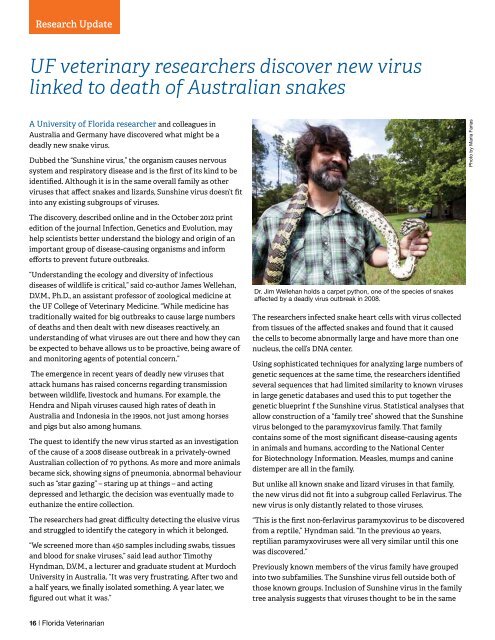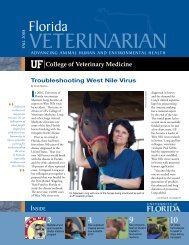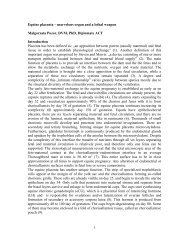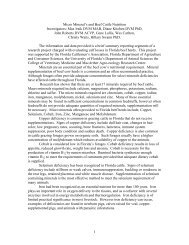Florida Veterinarian, Fall 2012 - University of Florida College of ...
Florida Veterinarian, Fall 2012 - University of Florida College of ...
Florida Veterinarian, Fall 2012 - University of Florida College of ...
You also want an ePaper? Increase the reach of your titles
YUMPU automatically turns print PDFs into web optimized ePapers that Google loves.
Research Update<br />
UF veterinary researchers discover new virus<br />
linked to death <strong>of</strong> Australian snakes<br />
A <strong>University</strong> <strong>of</strong> <strong>Florida</strong> researcher and colleagues in<br />
Australia and Germany have discovered what might be a<br />
deadly new snake virus.<br />
Dubbed the “Sunshine virus,” the organism causes nervous<br />
system and respiratory disease and is the first <strong>of</strong> its kind to be<br />
identified. Although it is in the same overall family as other<br />
viruses that affect snakes and lizards, Sunshine virus doesn’t fit<br />
into any existing subgroups <strong>of</strong> viruses.<br />
Photo by Maria Farias<br />
The discovery, described online and in the October <strong>2012</strong> print<br />
edition <strong>of</strong> the journal Infection, Genetics and Evolution, may<br />
help scientists better understand the biology and origin <strong>of</strong> an<br />
important group <strong>of</strong> disease-causing organisms and inform<br />
efforts to prevent future outbreaks.<br />
“Understanding the ecology and diversity <strong>of</strong> infectious<br />
diseases <strong>of</strong> wildlife is critical,” said co-author James Wellehan,<br />
D.V.M., Ph.D., an assistant pr<strong>of</strong>essor <strong>of</strong> zoological medicine at<br />
the UF <strong>College</strong> <strong>of</strong> Veterinary Medicine. “While medicine has<br />
traditionally waited for big outbreaks to cause large numbers<br />
<strong>of</strong> deaths and then dealt with new diseases reactively, an<br />
understanding <strong>of</strong> what viruses are out there and how they can<br />
be expected to behave allows us to be proactive, being aware <strong>of</strong><br />
and monitoring agents <strong>of</strong> potential concern.”<br />
The emergence in recent years <strong>of</strong> deadly new viruses that<br />
attack humans has raised concerns regarding transmission<br />
between wildlife, livestock and humans. For example, the<br />
Hendra and Nipah viruses caused high rates <strong>of</strong> death in<br />
Australia and Indonesia in the 1990s, not just among horses<br />
and pigs but also among humans.<br />
The quest to identify the new virus started as an investigation<br />
<strong>of</strong> the cause <strong>of</strong> a 2008 disease outbreak in a privately-owned<br />
Australian collection <strong>of</strong> 70 pythons. As more and more animals<br />
became sick, showing signs <strong>of</strong> pneumonia, abnormal behaviour<br />
such as “star gazing” – staring up at things – and acting<br />
depressed and lethargic, the decision was eventually made to<br />
euthanize the entire collection.<br />
The researchers had great difficulty detecting the elusive virus<br />
and struggled to identify the category in which it belonged.<br />
“We screened more than 450 samples including swabs, tissues<br />
and blood for snake viruses,” said lead author Timothy<br />
Hyndman, D.V.M., a lecturer and graduate student at Murdoch<br />
<strong>University</strong> in Australia. “It was very frustrating. After two and<br />
a half years, we finally isolated something. A year later, we<br />
figured out what it was.”<br />
Dr. Jim Wellehan holds a carpet python, one <strong>of</strong> the species <strong>of</strong> snakes<br />
affected by a deadly virus outbreak in 2008.<br />
The researchers infected snake heart cells with virus collected<br />
from tissues <strong>of</strong> the affected snakes and found that it caused<br />
the cells to become abnormally large and have more than one<br />
nucleus, the cell’s DNA center.<br />
Using sophisticated techniques for analyzing large numbers <strong>of</strong><br />
genetic sequences at the same time, the researchers identified<br />
several sequences that had limited similarity to known viruses<br />
in large genetic databases and used this to put together the<br />
genetic blueprint f the Sunshine virus. Statistical analyses that<br />
allow construction <strong>of</strong> a “family tree” showed that the Sunshine<br />
virus belonged to the paramyxovirus family. That family<br />
contains some <strong>of</strong> the most significant disease-causing agents<br />
in animals and humans, according to the National Center<br />
for Biotechnology Information. Measles, mumps and canine<br />
distemper are all in the family.<br />
But unlike all known snake and lizard viruses in that family,<br />
the new virus did not fit into a subgroup called Ferlavirus. The<br />
new virus is only distantly related to those viruses.<br />
“This is the first non-ferlavirus paramyxovirus to be discovered<br />
from a reptile,” Hyndman said. “In the previous 40 years,<br />
reptilian paramyxoviruses were all very similar until this one<br />
was discovered.”<br />
Previously known members <strong>of</strong> the virus family have grouped<br />
into two subfamilies. The Sunshine virus fell outside both <strong>of</strong><br />
those known groups. Inclusion <strong>of</strong> Sunshine virus in the family<br />
tree analysis suggests that viruses thought to be in the same<br />
16 | <strong>Florida</strong> <strong>Veterinarian</strong>

















